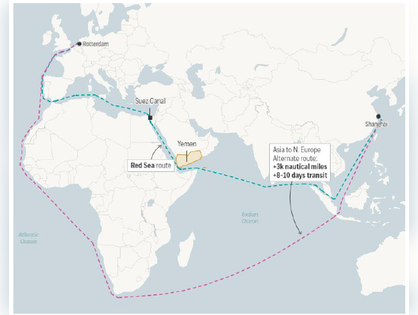Red Sea Crisis
Context
- A spate of attacks on cargo ships in the Red Sea since November by the Houthi militia of Yemen has turned the quickest marine route linking Asia with Europe through the Suez Canal unsafe.
- It has forced freighters to take a longer transit around the Cape of Good Hope in Africa’s southern tip, making shipments both dearer and longer to deliver.
Who are the Houthis and why are they attacking now?
- The Houthis are a Yemeni rebel group who control the west of the country, including its Red Sea coast.
- They are aligned with and supplied by Iran, but are politically independent.
- Houthi have significantly stepped up attacks on commercial shipping vessels travelling through the lower Red Sea since mid-November in response to Israel’s bombardment of Gaza.
Why is the Red Sea route important?
- The Red Sea, which provides access to the southern entrance to the Suez Canal, is the world’s main East-West trade route.
- It serves an important role in the global economy, with about 19,000 vessels traveling between the Indian Ocean and the Mediterranean Sea every year. The canal reduces the shipping distance between Asia and Europe almost by half.
- About 12% of global trade passes through the Red Sea, including 30% of global container traffic and $1 trillion worth of goods each year.

- At the southern end of the Red Sea is a narrow strait of water between Djibouti and Yemen: the Bab el-Mandeb Strait (32km). This is the area that the Houthi rebels in Yemen have been targeting.
Consequences
- An immediate consequence of the Red Sea conflict has been that major container and oil carriers have been forced to re-route shipments via the Cape of Good Hope.
- The re-routing has led to rising ocean freight, inflated insurance costs, and longer voyage times leading to delays and shortage of products. It has also driven up transportation costs.
How has it affected India?
- India’s trade with European and North African countries flows entirely through the Red Sea route which is almost 24% of its exports and 14% of its imports.
- Rising threats have prompted Indian exporters to hold back around 25% of their cargo ships transitioning through the Red Sea.
Subscribe
Login
0 Comments
